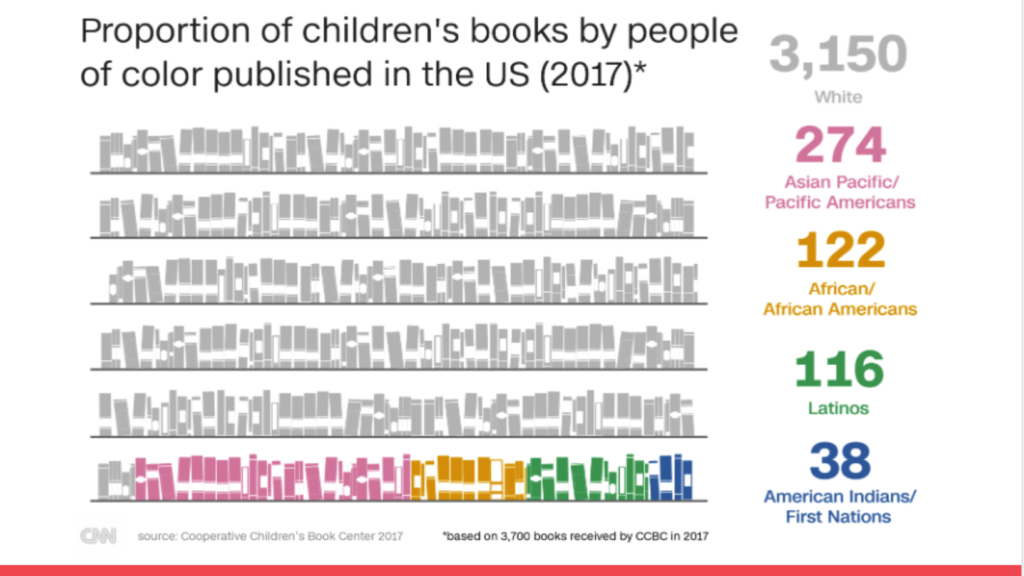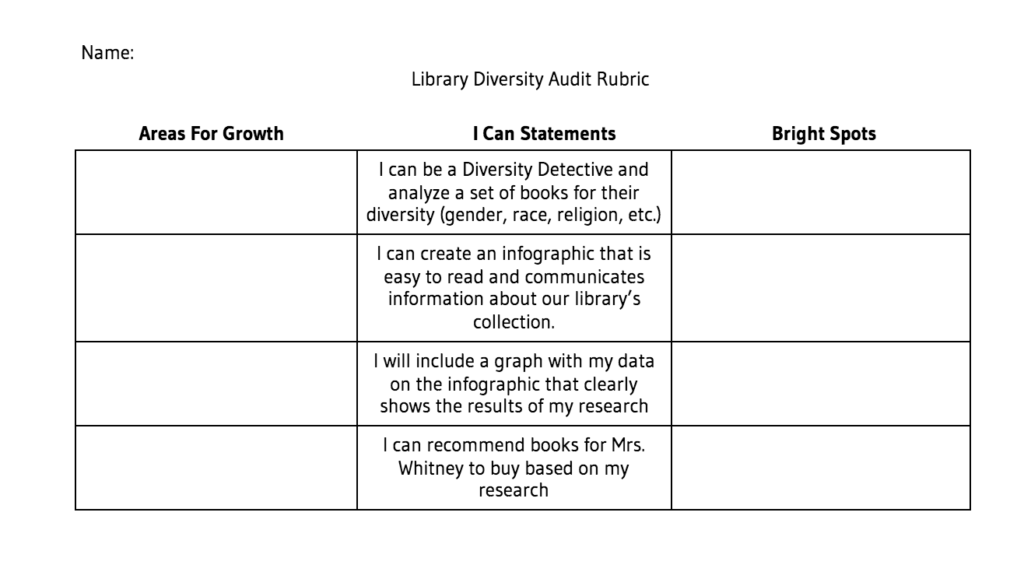The Case of The Library Diversity Audit
Whose stories are being told in your library? Whose stories are being left out?
Look around your library. It is such a beautiful space. It’s filled with vibrant colors and flexible furniture, student art and encouraging signs and posters. Maybe it has a makerspace. And it’s stocked full of books of all shapes, sizes and colors. Every book imaginable is available somewhere, from a YA-version Hamlet, to Winnie the Pooh and The Big Friendly Giant. Plus of course, Catcher in the Rye. You’ve got some new classics as well: Twilight, Hunger Games, City of Bones. Your collection is amazing. Why on earth would you need a library audit?
Except…
What’s a library audit?
Librarians audit their collections for any number of reasons. Books like to live, they like to find readers. Part of library management is curating which books to add and which to discard.
But recently, quite a few librarians have noticed that their collections represent only a minority of voices in the communities they serve. Publishing has favored a limited number of narratives. Those narratives feature a large number of protagonists who are white, who are male, who are able-bodied, who are straight. Those characteristics taken together reference a small set of the population. Therefore, many librarians are finding it useful to use lenses of diversity in conducting their audits. As you buy new books, and as you discard older ones, having lenses of race, ethnicity, gender, disability, sexual orientation and economic class — even a subset of those lenses — can make a collection more useful to its community.
And why did Ottauquechee need one?
“I thought about my students. Do they see themselves in the library?”
The Ottauquechee School, in Quechee VT, is home to an amazing library space. Work tables cluster under a wall of windows. Beanbags and soft, plush reading chairs beckon invitingly. Laptops sit ready atop a tech bar, and a whiteboard asks students to write questions for an upcoming discussion. And Ottauquechee School librarian Becky Whitney wanted to make sure the collection was just as welcoming as the space itself.
I was inspired from the Deeper Learning Conference we attended in 2018, and in one session we attended, called Little People have Big Ideas: Implementing a Social Justice Lens in Elementary, with Jeffrey Feitelberg, elementary students did a classroom library audit. And I always felt, because I didn’t have my own classroom, that I couldn’t make systemic change. I only see the students for 45 minutes a week — and then sometimes there’s holidays or vacations and field trips and then it’s two weeks until I see them. And I thought, “There’s really no way to make these great PBL projects in library.” It’s just not enough time to make it meaningful.
But when I went to that session, and the presenter talked about the kid’s classroom library, I just thought “I could do that with a very small segment of the library,” and then use it as a research project. The diversity audit, it kind of takes my responsibility and my passion and melds them.
Then I thought, there are a few students of color at our school. Where are they reflected in the library?
Becky knew that conducting a diversity audit of the library would not just improve the range of the collection, but teach students to be more critical readers. It would teach them to think powerfully about empathy and inclusion. So she got to work.
The Diversity Detectives are on the case
#1000Blackgirlbooks
Becky began by showing this inspiring video of 11 year old Marley Dias, a Black 6th grader who wanted to see herself in more books. Marley noticed the books she was reading in school were mostly about “white boys and dogs”. She wanted more books with characters who look like her. Her mother asked her, “Well, what are you going to do about it?” What Marley did was begin a movement demanding more racial diversity YA books. She went looking for #1000Blackgirlbooks, crowd-sourcing a collection of books with a Black female protagonist. She distributes the books to school libraries. The movement went viral, and kicked off a lot of powerful conversations for librarians around race in YA publishing.
But for Ottauquechee students, Marley’s activism provided a relatable example. Whose stories would they find in their own library? Whose stories did they want to find? Could everyone see themselves in the collection?
Dream of a Common Language
Becky introduced and unpacked the 4 Agreements of Courageous Conversations (Singleton & Linton) to her students:
- Stay engaged
- Speak your truth
- Expect discomfort
- Expect non-closure
They would use these four guidelines as a way to move through tough topics together.
Becky also worked with a community partner in this project, John Hall, the chair of the committee for Racial Inclusion and Equality in Hartford.
And what he said was, “Just the discussion was the important and powerful piece. The research is great, buying new and diverse books for the library is great,” but I would have done that anyway. So, including the kids in the discussion, including the kids and giving them agency, and giving them a voice in what kind of library, whose story are we telling — making them realize, the lack of diversity not okay.
Becky also defined specific lenses students could use in the audit. They could look for stories that featured diversity around race, religion, disability, and culture. Becky and her students chewed over the vocabulary together. They examined current data on the state of children’s book publishing and representation, then they moved into interest-based groups. They in effect became Diversity Detectives, studying Ottauquechee’s library collection for clues to inclusion.
Tackling the stacks…
…and making the case
The Diversity Detectives studied different sets of books in Ottauquechee’s library, using their Courageous Conversations agreements and the diversity lenses. They worked on analyzing the data they collected, then they created infographics in Canva. Here is a single point rubric Becky created for assessing the infographics. Lastly, students will share the infographics with their whole school community in the hopes of continuing discussions of inclusion.
Now be the change you want to see in the world.
For librarian Becky Whitney, this wasn’t just a theoretical exercise. The Diversity Detectives’ research will directly inform the direction Ottauquechee’s library collection takes as it grows. Taking the infographics and associated research into account, she will be partnering with the Diversity Detectives on recommended new purchases and culls. She also reached out to a local bookstore, in Norwich VT. The Norwich Bookstore’s proprietor, Liza Bernard, has agreed to share with students how she purchases books and what influences those decisions. All part of making sure this exercise remains more than academic. Becky hopes to come home from Norwich Bookstore with about 20 new titles based on the students’ research. Conversations around inclusion and diversity will have real-world relevance in Ottauquechee. They will shape the library collection, and hopefully extend to other areas of students’ lives.
Teaching the library audit
Becky ponders how she has challenged herself to move beyond her own initial discomfort with addressing these issues in school:
I’ve forced myself to be uncomfortable. I’m forcing myself to be aware of the language I use. And I had never understood that as fully as I have now because of the amount of research that I did, to make sure that I knew what I was talking about. It’s kind of like the whole — white fragility thing, and the whole thing about “I’m uncomfortable talking about race, and so I’m just going to not really talk about it.”
Students are leading these conversations and growing their agency, voice and understanding of critical issues in the process. And teachers are giving them the opportunity to share power and critically analyze their library spaces.
What does your library collection look like? How do you choose whose stories are included?
Further reading:
- Learn more about this library audit and other news at the Ottauquechee Library blog and Facebook page.
- Doing a YA Collection Diversity Audit: Understanding Your Local Community (School Library Journal)
- The Benefits and Limits of Diversity Audits (Reading While White)
- Equity Through the School Library (medium.com)
- How to Build a More Diverse Classroom Library (Lee and Low)
- Call to Action: Conduct a Diversity Audit (RA for All)
- Beyond the Collection Diversity Audit: Inclusion is More Than a Book, Why we should be auditing all of our library services for inclusion and best practices (School Library Journal)


